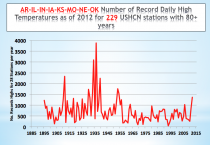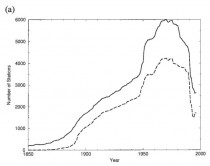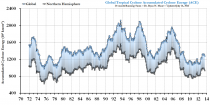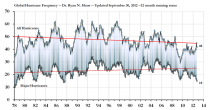By Anthony Watts,. Watts Up With That
A couple of days ago there was this PR from the University of Illinois at Urbana-Champaign. Icecap Note: Announcing the continuing ignorance on parade tour Wuebbles has been on even to the equally clueless Boxer committee with equally clueless other speakers
I decided it was just too ridiculous to get any traction. I was wrong, an even more ridiculous press release followed this one. Only one problem; Wuebbles doesn’t understand the difference between reality and reporting bias- Anthony
University of Illinois atmospheric sciences professor Donald Wuebbles will present a talk about how climate change is increasing the number of severe weather events at the 2013 AAAS meeting.
Climate change’s costly wild weather consequences
CHAMPAIGN, Ill. - Throughout 2012, the United States was battered by severe weather events such as hurricanes and droughts that affected both pocketbooks and livelihoods. Research suggests that in the coming years, U.S. five-day forecasts will show greater numbers of extreme weather events, a trend linked to human-driven climate change.
Donald Wuebbles, a professor of atmospheric sciences ![]() at the University of Illinois at Urbana-Champaign, will discuss extreme weather in a presentation Feb. 15 at the annual meeting of the American Association for the Advancement of Science in Boston.
at the University of Illinois at Urbana-Champaign, will discuss extreme weather in a presentation Feb. 15 at the annual meeting of the American Association for the Advancement of Science in Boston.
In recent decades, multi-day heat waves and severe precipitation have become more frequent. For example, in the U.S. in the 1950s, the number of days that set record high temperatures was equal to the number of days that set record low temperatures. By the 2000s, the United States was twice as likely to see a record high as a record low.
“Human-driven climate change is in fact driving changes in severe weather, and that leads to a lot of potential impacts in both humans and wildlife that end up being costly in many different ways,” Wuebbles said.
As the global climate changes, normal weather patterns are altered. This is because the increasingly warmer atmosphere holds larger amounts of water vapor, which energizes storms, Wuebbles said.
The consequences of severe weather are much greater than the disappointment of a missed picnic or the inconvenience of a power outage. Weather-related disasters incur huge expenses, taxing both public funds and private equity. According to the National Oceanic and Atmospheric Administration, 11 extreme weather events costing more than $1 billion each occurred in 2012.
“What we’ve seen in general is that the number of billion-dollar events has increased over the last three decades,” Wuebbles said. “It’s not just hurricanes, it’s really a number of different types of weather extremes that are increasing, and that’s what the worry is.”
In his talk, Wuebbles will discuss the current understanding of severe weather in relation to the science of climate change, as well as speak about the issues and uncertainties that will affect the U.S. and world in the coming years.
----------
OK today we have this press release from AAAS:
Scientists Say Wild Weather Is Here to Stay
Cable news junkies, take heart: if you love wall-to-wall coverage of hurricanes, wildfires and superstorms, your future viewing schedules will be jam-packed.
Researchers at the AAAS Annual Meeting said that wild weather events like Superstorm Sandy and the severe Texas drought are the new normal in North America, as human-driven climate change has made these events more intense and more frequent.
This GOES-13 satellite image was captured on Oct. 31 at 1240 UTC as Sandy’s circulation was winding down over Pennsylvania. Sandy had been downgraded a remnant low pressure area. Credit: NASA GOES Project
Consider these facts:
- In the 1950s, the number of days that set record high temperatures in the U.S. was equal to the number of days that set record low temperatures. By the 2000s, record highs were twice as likely as record low.
- The amount of precipitation falling in the heaviest rain and snow events in the United States has increased by nearly 20% since the 1950s.
- Since the 1970s, the Atlantic Ocean has seen substantial increases in nearly every measure of hurricane activity, from frequency to storm intensity.
“The scientific analyses are now indicating a strong link between changing trends in severe weather events and the changing climate,” said Donald Wuebbles, an atmospheric scientist from the University of Illinois. “Every weather event that happens nowadays takes place in the context of a changed background climate.”
“Globally the temperatures are higher, the sea levels are higher, and there is more water vapor in the atmosphere, which energizes storms. So nothing is entirely natural anymore,” he said. “The background atmosphere has changed and continues to change due to human activity.”
Extreme weather took political center stage earlier this week, when U.S President Barack Obama mentioned Superstorm Sandy and other severe weather events in his State of the Union speech.
However, the president was careful to note that “no single event makes a trend” an idea echoed by the researchers at a AAAS news briefing.
“While a particular heat wave may have still have occurred in the absence of human-induced warming,” Wuebbles explained, “it would not have been as hot, or lasted this long, and such events would not occur as frequently.”
Ok Bozo explain the dust bowl of the 1930s and the 7 year drought from 1949 to 1956.
Ecologists and wildlife biologists have been steadily compiling evidence that climate change has profound effects on plants and animals, affecting where they thrive and when they breed or flower, among other events. But University of Texas at Austin biologist Camille Parmesan said some of these changes also can be driven by extreme weather events - even just a few days of extreme heat or rainfall.
Climate change interacts with other factors such as pollution and shrinking habitats to affect plant and animal populations, Parmesan acknowledged. But, she said, studies of coral reefs and other natural habitats suggest that “if we reduce these other human stresses, we actually can increase resilience and resistance in natural ecological systems.”
It remains to be seen whether humans can be similarly resilient in the face of extreme weather, the researchers said. The past holds several examples of other societies that did not fare so well under severe climate change.
Tree-ring records from the American Southwest, for example, suggest that drought during the 13th century may have driven the residents of Mesa Verde, Colorado to flee their fields and homes. “The historical record shows us a community that may have failed environmentally,” said David Stahle, a tree-ring scholar from the University of Arkansas. “We are doing the same thing now in terms of our heavy consumption of water and fossil fuels.”
Wuebbles said he has talked with farmers in the American Midwest who are already changing planting times and seed types in response to recent years of severe drought and floods. And other states are grappling with the financial implications of a future of weather extremes.
Texas State climatologist John Nielsen-Gammon has been tracking the fallout from his state’s ongoing drought, which he said was triggered more by extreme high temperatures than a lack of rainfall.
Reservoirs are at their lowest levels since the 1990s, and the state legislature will meet this spring to discuss a water plan that ensures supplies for the next 50 years. “But it costs $53 billion,” Nielsen-Gammon said, “and there’s presently no mechanism to fund it.”
“Up until this point, climate change has been largely an abstract concept because some of the United States has not seen a large increase in temperatures until just recently,” he added. “The awareness of the importance of dealing with climate change is just now becoming apparent within our state.”
Dr. Wuebbles might do well to read and understand how the march of technology has created a reporting bias in “cable news” providing us with “wall to wall coverage”:
And for his three points, the real facts are in [brackets in blue]:
- In the 1950s, the number of days that set record high temperatures in the U.S. was equal to the number of days that set record low temperatures. By the 2000s, record highs were twice as likely as record low. [Yes, but does Dr. Wuebbles know that most of the weather stations setting new records are NEW stations that have been added since then? See graph below
Above is Figure 2a from NOAA/NCDC Peterson and Vose (1997), showing the change in temperature reporting stations over time for daily mean temperatures (solid line) and min/max temperatures (dotted line). Note that the number of stations added after 1950 was the biggest jump, and with so many new stations, it is logical that they’d set new records for their locations. Combine this with the growth of cities (UHI) and spectacularly poor station siting, and it is not at all surprising there are more warm records than cold.]
- The amount of precipitation falling in the heaviest rain and snow events in the United States has increased by nearly 20% since the 1950s. [Again, this can be explained by the addition of more weather stations after 1950, with more stations with rain and snow gauges added, you’ll see more events due to better spatial coverage. Rain and snow bands can often be very narrow, particularly from thunderstorms, and so catching these is dependent on a station being under the event]
- Since the 1970s, the Atlantic Ocean has seen substantial increases in nearly every measure of hurricane activity, from frequency to storm intensity. [ This is double plus wrong, see the graphs of Global Accumulated Cyclone Energy and Frequency below:
And...finally…
Prof. Roger Pielke Jr. says
Let’s take a step back. The science on climate change, extreme events and disaster costs is clear and unambiguous. You don’t need to take my word for it, you can find the science well summarized in the IPCC SREX. And if you don’t like the IPCC you can find an array of peer-reviewed literature. I am happy to debate this topic with all comers as the data and analyses overwhelming support the claims below.
US floods have not increased over a century or longer (same globally).
US hurricane landfall frequency or intensity have not increased (in US for over a century or longer).
US intense hurricane landfalls are currently in the longest drought (7 years+) ever documented.
US tornadoes, especially the strongest ones, have not increased since at least 1950.
US drought has decreased since the middle of the past century.
US East Cost Winter Storms show no trends (here also).
Disaster losses normalized for societal changes show no residual trends (US, other regions or globally).
The only thing that has increased that is extreme, is Dr. Wuebbles opinions.








